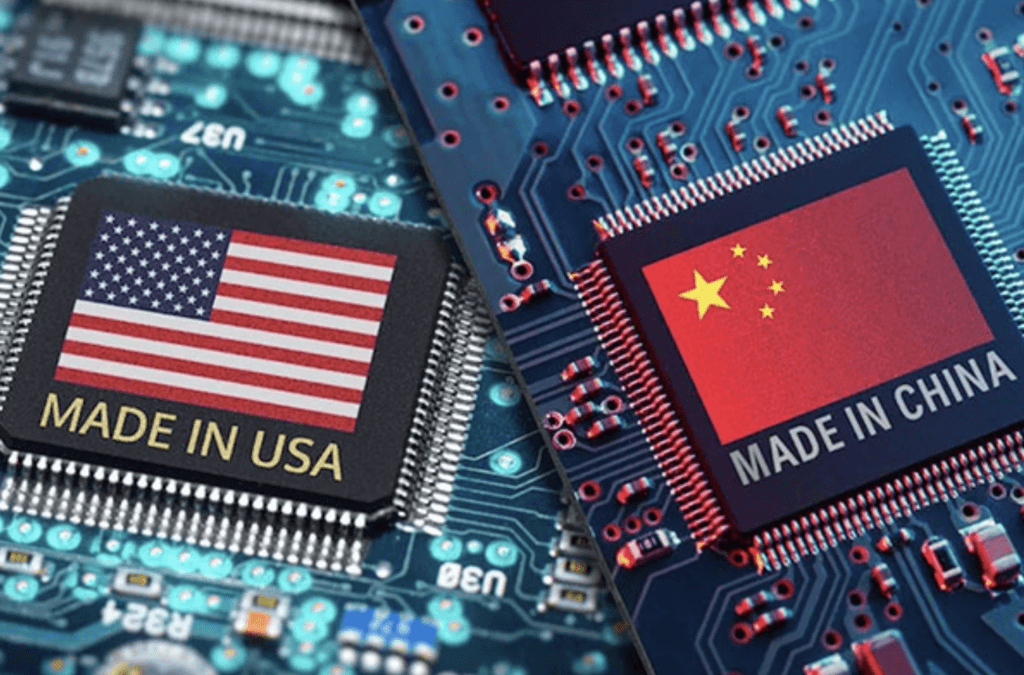
In recent years, the global tech landscape has witnessed a significant shift as “China replaces US chips” becomes a reality. This transformation stems not only from the strategic vision of China’s government but also from a necessity to reduce reliance on foreign technologies amidst geopolitical uncertainties. As trade tensions escalated, China’s semiconductor industry emerged as a beacon of innovation and self-sufficiency.
China’s determination to replace U.S. technology and solidify its position as a leader in chip manufacturing has spurred unparalleled investments in research, development, and production capabilities. This ambition aligns seamlessly with the goals of “Made in China 2025,” which prioritizes the development of key technologies such as artificial intelligence, 5G networks, and semiconductors.
The competition between the “MADE IN USA” processor and the emerging prowess of Chinese chips embodies a larger, global narrative. U.S. semiconductors have long been praised for their reliability, precision, and cutting-edge capabilities. However, the Chinese “MADE IN CHINA” processors are quickly becoming a force to reckon with, showcasing advanced energy efficiency and computational power tailored to modern applications.
The Rise of China’s Semiconductor Industry
China’s semiconductor industry is rapidly evolving, bolstered by both governmental support and private-sector innovation. Major hubs such as Shenzhen and Shanghai have become the epicenters of technological breakthroughs. With state-backed funding and academic partnerships, institutions and companies are fostering innovations that can rival those of established American chipmakers.
One of the crown jewels of China’s technological future is its ability to manufacture microchips that cater to a wide array of sectors. From Internet of Things (IoT) devices to sophisticated platforms for complex data analytics, the Chinese “MADE IN CHINA” chip is solidifying its mark on the global stage. Its fusion of energy efficiency and computational prowess underscores China’s intent to dominate sectors where innovation is key.
Moreover, the global semiconductor market is projected to grow exponentially, making it crucial for nations to safeguard their positions. The reported figure of over $1 trillion in potential revenue by 2030 highlights the importance of this industry. For China, achieving self-reliance and reducing dependence on Western technologies isn’t just about politics; it’s about securing an economic stronghold in a critical domain.
Comparing “MADE IN USA” and “MADE IN CHINA” Microchips
When comparing U.S. and Chinese microchips, unique strengths on both sides become apparent. The “MADE IN USA” processor boasts unparalleled performance. Designed with state-of-the-art nanotechnology, this chip is the cornerstone for applications requiring immense computing power, such as artificial intelligence, quantum computing, and high-speed data processing. Its sleek, robust architecture ensures reliability and precision that have made U.S. chips synonymous with excellence.
On the other hand, the “MADE IN CHINA” processor leverages cutting-edge advancements in energy efficiency and is fast becoming a leader in computational power. While it might not yet match the performance of the most advanced American chips, it demonstrates strong versatility and adaptability for next-generation technologies like IoT, consumer electronics, and smart platforms.
Together, these chips represent a shift toward global competitiveness. While the U.S. remains a sanctuary of advanced semiconductor innovation, China’s ability to rapidly enhance its technology and production infrastructure has placed it on the same table. This development reflects how two economic giants are influencing innovation and defining a new era of technological growth.
Challenges and Opportunities for China
Although China’s growth in the semiconductor sector has been remarkable, challenges remain. One of the most pressing issues is access to certain advanced tools and technologies. U.S. export controls and restrictions on semiconductor manufacturing equipment highlight how geopolitical challenges can stymie progress. Additionally, producing chips with smaller nanometer technologies continues to be a hurdle for many Chinese manufacturers compared to their U.S. counterparts.
Despite these hurdles, opportunities abound. Increased investment in local talent and academic partnerships has accelerated the pace of innovation. Companies like Huawei and SMIC are leading the charge, developing chipsets that demonstrate growing parity with U.S. technologies. Furthermore, collaborations with neighboring countries and emerging markets provide an avenue to increase market penetration and brand visibility.
China’s quest to replace U.S. chips also serves as an inspiration for other developing nations seeking technology independence. The boost to the domestic semiconductor industry promotes a sense of national pride and ensures that innovation moves forward regardless of obstacles.
The Future of Chip Manufacturing
The future of chip manufacturing lies in innovation, adaptability, and global competition. With China on the rise, semiconductor manufacturing is no longer the sole domain of the U.S., South Korea, and Taiwan. The “China replaces US chips” trend is redefining the playing field, showing how a combination of state support, skilled labor, and focused ambition can close technological gaps.
As the stakes climb, cross-border collaborations and competition will push boundaries in energy efficiency, design, and computational capabilities. The convergence of American and Chinese craftsmanship illuminates a world where both nations contribute to a technological revolution.
China’s ascent in the chip industry underscores a global shift where technology is no longer monopolized by a few players. Instead, it is shaped by the contributions of nations driven by ambition, expertise, and creativity. Whether the “MADE IN CHINA” chip fully outpaces its “MADE IN USA” counterpart remains a question for the future, but one thing is certain—this rivalry is fueling the engines of progress for the entire world.